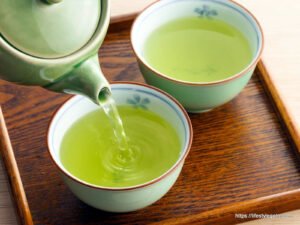Green tea, a time-honored beverage with origins dating back thousands of years, has garnered global acclaim for its numerous health benefits and cultural significance. Derived from the leaves of the Camellia sinensis plant, green tea has been an integral part of traditional Asian medicine and culture for centuries. In recent years, scientific research has shed light on the remarkable health-promoting properties of green tea, turning it into a popular choice among health enthusiasts worldwide. This essay explores the rich history, cultivation, processing, and health benefits of green tea, highlighting its role as a treasured elixir for both the body and mind.
Green Tea: Unraveling the Health Benefits and Cultural Significance

Section 1: A Journey through History
1.1 Origin and Spread:
The origins of green tea can be traced back to ancient China, where it is believed to have been discovered more than 4,000 years ago during the Shang dynasty. Legend has it that Emperor Shen Nong, known as the “Divine Healer,” accidentally discovered tea when tea leaves fell into his boiling water. Fascinated by the pleasant aroma and refreshing taste, he began to study the properties and medicinal benefits of tea. Over time, the knowledge of tea cultivation and preparation spread throughout China and neighboring regions, including Japan, Korea, and India.
1.2 Early Use as Medicine:
In ancient China, green tea was highly regarded for its medicinal properties. Traditional Chinese medicine attributed numerous health benefits to green tea, ranging from promoting digestion and boosting energy to improving mental clarity and strengthening the immune system. Chinese scholars and physicians documented its uses and benefits in herbal texts, emphasizing its role in maintaining harmony and balance in the body.
1.3 Cultural Significance:
Green tea quickly became an integral part of Chinese culture and social life, evolving into a symbol of hospitality, respect, and wisdom. The famous Chinese tea ceremony, Gongfu Cha, exemplifies the art of tea preparation and serves as a cultural expression of grace and mindfulness. Similarly, in Japan, the traditional tea ceremony known as Chanoyu celebrates the aesthetics of simplicity and tranquility, reflecting the deep respect for nature and mindfulness of the present moment.

Section 2: Cultivation and Processing
2.1 Camellia Sinensis Plant:
Green tea is derived from the leaves of the Camellia sinensis plant, a species that also produces black, white, and oolong teas. The difference in tea types results from variations in processing methods and oxidation levels. For green tea, the leaves are minimally oxidized, preserving their natural color and flavor, and undergo various processing steps to create the final product.
2.2 Cultivation:
The cultivation of Camellia sinensis requires specific environmental conditions, including adequate rainfall, fertile soil, and moderate temperatures. Green tea is primarily grown in regions with a temperate climate, such as China, Japan, Korea, India, and parts of Southeast Asia. The unique combination of geographical factors and cultivation techniques contributes to the distinct flavors and aromas of green tea varieties from different regions.
2.3 Harvesting and Processing:
The harvesting and processing methods significantly influence the quality and characteristics of green tea. For high-quality green tea, the leaves are hand-picked during specific periods of growth when they contain the optimal balance of nutrients and flavor compounds. The freshly harvested leaves are then steamed or pan-fired to halt oxidation, preserving the vibrant green color and delicate taste. Afterward, the leaves undergo rolling, shaping, and drying processes to create the final tea leaves or tea powder.

Section 3: Nutritional Composition of Green Tea
3.1 Polyphenols:
One of the key components that contribute to the health benefits of green tea is its rich content of polyphenols, particularly catechins. Epigallocatechin gallate (EGCG) is the most abundant and potent catechin present in green tea. These polyphenols possess powerful antioxidant properties, scavenging free radicals in the body and protecting cells from oxidative stress and damage.
3.2 Caffeine:
Green tea contains a moderate amount of caffeine, significantly less than that found in coffee. The caffeine content in green tea contributes to its mild stimulant effect, promoting alertness and mental focus without the jittery side effects associated with higher caffeine doses.
3.3 Vitamins and Minerals:
Green tea is a natural source of essential vitamins and minerals, including vitamin C, vitamin B complex (thiamine, riboflavin, niacin), vitamin E, and trace minerals like potassium and manganese. These nutrients play vital roles in supporting overall health and well-being.

Section 4: Health Benefits of Green Tea
4.1 Antioxidant Properties:
The high concentration of catechins, particularly EGCG, in green tea accounts for its potent antioxidant effects. These antioxidants neutralize harmful free radicals in the body, reducing oxidative stress and cellular damage. As a result, regular consumption of green tea may lower the risk of chronic diseases such as heart disease, certain cancers, and neurodegenerative disorders.
4.2 Cardiovascular Health:
Numerous studies have linked green tea consumption to improved cardiovascular health. The polyphenols in green tea may help lower LDL cholesterol levels, improve blood vessel function, and reduce the risk of atherosclerosis, thus promoting heart health and reducing the risk of heart disease and stroke.
4.3 Weight Management:
Green tea has gained popularity as a potential aid for weight management. Catechins, particularly EGCG, have been found to boost metabolism and increase fat oxidation, promoting weight loss and fat reduction. Additionally, the combination of caffeine and catechins may enhance physical performance and endurance during exercise, supporting active lifestyles.
4.4 Brain Health:
Green tea’s polyphenols and caffeine content have been linked to improved cognitive function and a reduced risk of cognitive decline. Studies suggest that regular green tea consumption may help enhance memory, attention, and mental clarity, supporting overall brain health and longevity.
4.5 Immune Support:
The immune-boosting properties of green tea can be attributed to its catechins and other bioactive compounds. Green tea’s ability to modulate the immune response may help the body defend against infections and illnesses, strengthening the immune system’s ability to fight off pathogens.
4.6 Anti-Inflammatory Effects:
Green tea’s polyphenols have demonstrated anti-inflammatory properties, reducing inflammation and the risk of chronic inflammatory conditions such as arthritis and inflammatory bowel disease. These effects contribute to overall health and may help alleviate symptoms associated with inflammation.

Section 5: Green Tea and Cancer Prevention
5.1 Cancer Epidemiology:
Research into the relationship between green tea consumption and cancer prevention has yielded promising results. Epidemiological studies have shown that populations with higher green tea consumption exhibit a lower incidence of certain cancers, particularly breast, prostate, lung, and digestive tract cancers.
5.2 Mechanisms of Action:
Green tea’s cancer-preventive effects are thought to be attributed to the high levels of polyphenols, particularly EGCG. These polyphenols have been shown to inhibit cancer cell growth, promote cell death (apoptosis), and prevent angiogenesis, the formation of blood vessels that feed tumors.
5.3 Clinical Studies:
Clinical trials investigating the potential role of green tea in cancer prevention and treatment are ongoing. While results are promising, further research is needed to establish definitive recommendations. Green tea consumption is not intended to replace conventional cancer therapies but may complement overall cancer prevention strategies.

Section 6: Brewing and Consumption
6.1 Brewing Techniques:
The art of brewing green tea is integral to unlocking its full flavor and health benefits. Different types of green tea require varying brewing temperatures and steeping times. As a general guideline, the water temperature should range from 160°F to 180°F (71°C to 82°C) for delicate green teas and up to 185°F (85°C) for heartier varieties. Steeping times can vary from 1 to 3 minutes, depending on the desired strength of the tea.
6.2 Tea Ceremony and Cultural Practices:
Green tea holds a special place in various cultural practices and ceremonies worldwide. From Japan’s elaborate Chanoyu to China’s traditional Gongfu Cha, these tea ceremonies are a celebration of mindfulness, hospitality, and cultural heritage. In these rituals, the preparation and presentation of green tea are meticulously executed, emphasizing the value of serenity and connection with nature.
6.3 Iced Green Tea and Other Culinary Uses:
Green tea can be enjoyed in various forms beyond the traditional hot brew. Iced green tea, sweetened or unsweetened, is a refreshing option, particularly during warmer months. Additionally, green tea can be used as an ingredient in culinary creations, such as green tea-infused desserts, smoothies, and even savory dishes.

Section 7: Green Tea and the Environment
7.1 Sustainability:
As green tea gains popularity worldwide, it is essential to consider its impact on the environment. Sustainable cultivation practices, such as organic farming and fair trade initiatives, promote eco-friendly tea production and support the well-being of tea farmers. Sustainable sourcing of green tea ensures the preservation of natural resources and protects biodiversity in tea-producing regions.
7.2 Packaging and Waste Reduction:
With the increase in green tea consumption, minimizing packaging waste becomes crucial. Choosing loose-leaf green tea or compostable tea bags can help reduce plastic waste. Additionally, recycling or repurposing used tea leaves can contribute to waste reduction and sustainable gardening practices.

Section 8: Green Tea and Modern Lifestyle
8.1 Integrating Green Tea into Daily Routine:
Incorporating green tea into daily routines can be a simple and enjoyable practice. A cup of green tea in the morning or afternoon can provide a gentle energy boost and mental clarity without the crash associated with higher caffeine sources. Green tea can also be enjoyed during meditation or relaxation sessions, further enhancing the experience of mindfulness and inner peace.
8.2 Green Tea and Stress Management:
Green tea contains the amino acid L-theanine, known for its relaxation-promoting effects. L-theanine has been shown to reduce stress and anxiety while promoting a sense of calm and mental focus. Incorporating green tea into stress management strategies can be beneficial for individuals seeking natural ways to unwind and find balance in their lives.

Section 9: Green Tea Precautions and Considerations
9.1 Caffeine Sensitivity:
While green tea contains less caffeine than coffee, individuals sensitive to caffeine should exercise moderation in their consumption. Decaffeinated green tea is available as an alternative for those seeking the health benefits of green tea without the caffeine content.
9.2 Interactions with Medications:
Green tea may interact with certain medications, affecting their efficacy or potentially causing adverse effects. Individuals taking medications should consult their healthcare provider before incorporating green tea into their routine to ensure safe consumption.
9.3 Green Tea Extracts and Supplements:
Green tea extracts and supplements, often promoted for their concentrated health benefits, should be used with caution. Excessive consumption of green tea extracts may lead to adverse reactions and is not recommended without medical supervision.

Green tea, with its rich history, remarkable health benefits, and cultural significance, stands as a timeless elixir that continues to captivate people around the world. From ancient times to the modern era, green tea has been celebrated for its role in promoting health and harmony. Its potent antioxidants, potential cancer-preventive properties, and calming effects have placed green tea at the forefront of natural health remedies and culinary delights.
As we journey through the legacy of green tea, we uncover its potential to nourish not only our bodies but also our souls. Through mindful brewing, cultural appreciation, and sustainable practices, green tea can enrich our lives, connecting us with centuries of tradition and wisdom. Embracing the art of green tea consumption, we can savor its delicate flavors, cultivate serenity, and embark on a journey of well-being and vitality that transcends time and borders. Whether shared in a tea ceremony or enjoyed during moments of solitude, green tea remains a cherished companion in our pursuit of a healthy and balanced life.
See more:

